The Legend of Zelda: Breath of the Wild Review – Is it worth playing now?
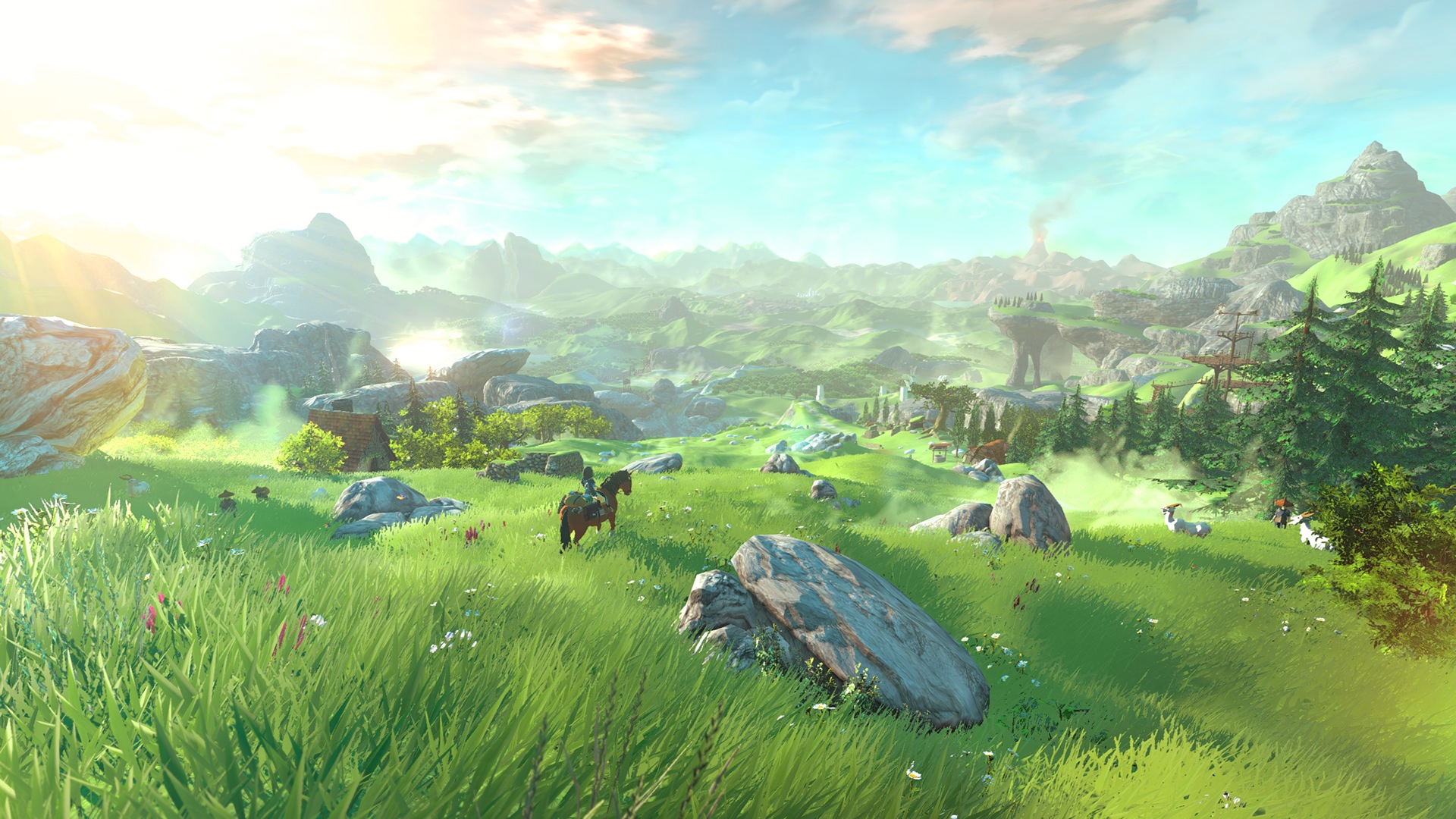
After being late to the party in getting a Switch, I’ve poured in over 150 hours into The Legend of Zelda; Breath of the Wild during lockdown here in the UK, after picking it up in May.
I’m a big fan of the Zelda franchise generally, but my enthusiasm for the series has waned after playing through the more recent entries Skyward Sword and Twilight Princess, which I found veered away from what, in my view, made the series great. These entries represented more linear, streamlined and story-driven experiences as opposed to the open-ended, exploration-orientated games of the past. See this article on The crucial things Skyward Sword got wrong I wrote back in 2016 for what I mean.
At first glance, Breath of the Wild (BotW) appears to address many of the issues I’d had with those games, and promised to be the most ambitious and bold entry in the series to date, offering a vast expansive open world, minimal handholding and shackle-free exploration.
But did it deliver? And is it worth playing today?
Here’s the good, the mixed in the bad of BotW:
The Good

Baby steps: The game starts you off on the Great Plateau – a sizeable chunk of land in SouthWest Hyrule, in which you learn the ropes. The Plateau alone is easily larger than the hubs of previous titles, and contains the main elements you’ll come across in the world; snowy peaks, forests and lava pits, allowing you to get accustomed to the game’s environmental mechanics.
On the Plateau you’ll also acquire the core skills of your Sheikah Slate (a tablet you pick up right at the beginning) in four shrines, before you’re given the paraglider, which allows you to traverse the rest of Hyrule. It’s the first game in the series that equips you with all of your tools right form the off, rather than gradually acquiring them as you go.
The Plateau is a brilliant tutorial because it introduces the player to the key elements and tools of the game and does so in a very refreshing way. The player is free to explore this giant area and tackle the shrines within it at their leisure, with multiple ways to access each. For instance, there’s one atop a snowy peak, but Link will suffer from the cold and taker damage if he approaches it unprepared. I discovered that my body temperature rose when I set a stick on fire and carried it, thus I traversed up the mountain this way, but there are several other ways to solve this issue and get up there. This philosophy of multiple approaches based on intuition is a key theme of the game, and is one of the best parts about it.
Scale and size: If there’s one department that exceeded my expectations, it’s the sheer size of Hyrule in BotW. As impressive and expansive as the vista is when you step out of the cave at the beginning, it actually doesn’t reflect just how big the continent is, which seems to stretch out endlessly in every direction as you explore it. It’s a world that actually feels large in a realistic way, with swathes of countryside and mountains in between the towns, and roads that go on for miles through the hills. The lakes are vast, the forests and woodland are dense and full of life; the whole thing begs to be explored. It’s extremely impressive how Nintendo have managed to craft a world of such scale.
Wind Waker Wanderlust: The best thing about the GameCube’s Wind Waker was the sense of open discovery the game bestowed upon the player when they set off across the open sea, able to sail in any direction, towards any island they spotted on the horizon. This feeling of wanderlust was never quite captured in subsequent entires to the series, and in fact seemed to diminish over time as the games become more linear.
Thankfully BotW has done a complete pivot on this philosophy, and harkens back to the spirt the Great Sea sea founded almost 20 years ago. The joy of spotting an interestingly shaped mountain peak or dense forest in the distance and making your way over to it is the best part of BotW, as it was in The Wind Waker, and practically every spot of the map has something to offer making it worth discovering.
Unique verticality: Something I quickly found when attempting to get to my desired destination was that I’d invariably get distracted from my goal on the way there, and end up forgetting where I was headed in the first place. With The Wind Waker, this was never an issue as you only had the wide open sea between you and your goal, which always remained visible in the distance. BotW is as densely packed as it is vast, meaning focusing in on your destination with the blinkers on is almost impossible.
Verticality to this degree is something I’ve never experienced before. What I mean by verticality is that there are absolutely no boundaries for Link – every single path, road, cave and river can be approached from any angle, and every inch of surface area crawled over; meaning you’re able to shoot off in any direction at any given time, on the X, Y and Z axis. There’s a causeway leading to Kakariko Village from the east, clearly designed so you can make your way down it through to the village. However, knowing that up the cliffside wall at any given point there was more to explore, and therefore something I was missing out on simply by following the path, was a unique sensation – a sense of freedom unparalleled in any game I’ve played before.
Even huge, free open world games like Skyrim and The Witcher 3 have their boundaries within the map, but not so in BotW. Link can climb anything and everything, limited only by a stamina bar that you increase pretty quickly in capacity. When I discovered this, initially I thought Nintendo would be clever with it and deliberately design areas of the world to only be accessible once the stamina bar is maxed out, or indeed hide places away entirely, making them technically accessible but actually not practically accessible due to lack of the player’s progress. Amazingly though this isn’t the case, and everywhere can be accessed at any point and any time. Of course it’s easier to get to places once you’ve spent time getting the right gear and higher stamina, but with thoughtful play you can basically be anywhere.
This does make for some interesting occasions when you discover a new area from an odd angle, and later see a path that the designers clearly would have preferred you to enter that area from. For example the beautiful winding canyon pathways up to Zora’s Domain. But although there’s just no way they could make every area’s discovery a beautiful set piece and kept the philosophy of freedom intact, it’s still genuinely impressive how they’ve knitted together a Hyrule that keeps discovery fascinating and a real pleasure, regardless of direction of approach.
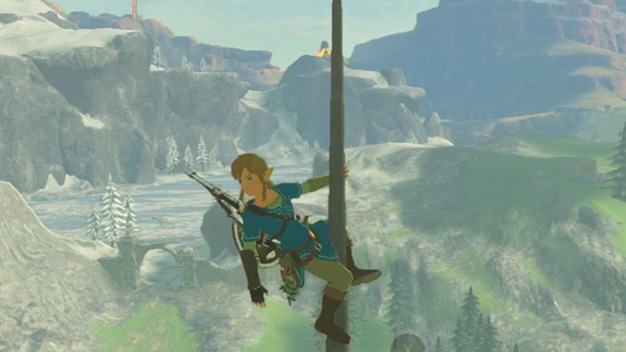
Non-Ubi world: My biggest bugbear with open world games is that most are open-world simply for the sake of it, and comprise of copy-pasted locations, enemy camps and buildings patch-worked together with no real feeling of craft. Ubisoft games are notorious for this, and Skyrim too became infamous for it’s copy-pasted cave dungeons. BotW is probably the biggest open world I’ve experienced, and so going in I expected to see the same cave formation, the same lake, the same hilltop copy-pasted throughout Hyrule. What is amazing is that there’s nothing of the sort. The whole land feels created by hand and with care; every crevice, every inlet, every mountain path, every pond and forest are unique. This means the thrill of discovery never really wanes, as you never quite know what to expect in terms of environment.
This is even better when you haven’t unlocked a region of the map yet (more on that shortly) and there’s nothing on your radar or map whatsoever – meaning anything could spring up over the next hill or around the next corner. I can’t imagine what a laborious task designing Hyrule must have been, knowing every inch of it would potentially be touched by the newly limitless Link, and committing to making every part interesting.
Another pitfall of Ubisoft open worlds are the map icons. Upon unlocking a region in a Ubi game, the map becomes littered with icons and ‘points of interest’. The designer’s intention is clear – they want you to be able to experience as much of their world as possible, so tempt you to these places with the rewards. Sadly, it actually has the opposite effect. In marking everything on the map, the game strips away any sense of discovery from the player, as you’re not going to go near anywhere that doesn’t have an icon, and if you already know a spot has an icon, there’s no feeling of discovery and wonder when you approach it. BotW succeeds here where Ubi games fail, as whilst you do unlock regions of the map via towers, the map doesn’t auto populate. So if you see an interesting looking cave in the distance, there may be something there, or there may not. The wonder remains intact.
Art design: BotW is a good example of art direction being more important than technical graphical fidelity. The style is something of a mix between the two best looking Zelda games – Skyward Sword and Wind Waker, and it feels like this is the game that Skyward Sword threatened to be at times (and this remains true in other areas besides graphics) but didn’t quite manage it. BotW has the bold cell shaded colours and expressive characters of the Wind Waker, and SS’s watercolour like tinge to everything, particularly the distance – and you’ll be peering into the distance a lot in this game. Certain areas are more impressive than others of course, highlights for me being the glowing lava flows of death mountain, matched with the wobbly haze of hot air and falling ash rain; and the water – Nintendo have always been great at water, and BotW sees them flex their aquatic muscles with huge lakes, winding rivers and an expansive sea surrounding the world. It’s a beautiful sight.
Quiet moments: Another quality of older Zelda games I enjoyed were the quiet moments of downtime. Fishing or Poe hunting in Ocarina of Time or sailing along gently in Wind Waker looking for treasure chests provided lovely moments of calm serenity that juxtaposed the dungeon crawling action in the rest of the game, and showed a world away from the monsters that felt worth saving. Again, more recent games in the series seemed to do away with these elements, much to their determent. Thankfully BotW brings these moments back with success, and scratches this itch for peace more so than any other in the series. You’re never far away from a glade of trees, a lonely hilltop or a crumbling ruin of a building that gives you an opportunity to sit still and soak in the world around you. And theres often no music, which serves to heighten the feeling of solitude.
Other respite areas come in the form of stables, which are scattered throughout the land and serve as a nice place to rest, pick up quests, meet NPCs and of course ‘register’ horses you’ve picked up. In the harsh, unforgiving wildlands of Hyrule the stables serve as effective breaks to relax and enjoy meeting some colourful characters.
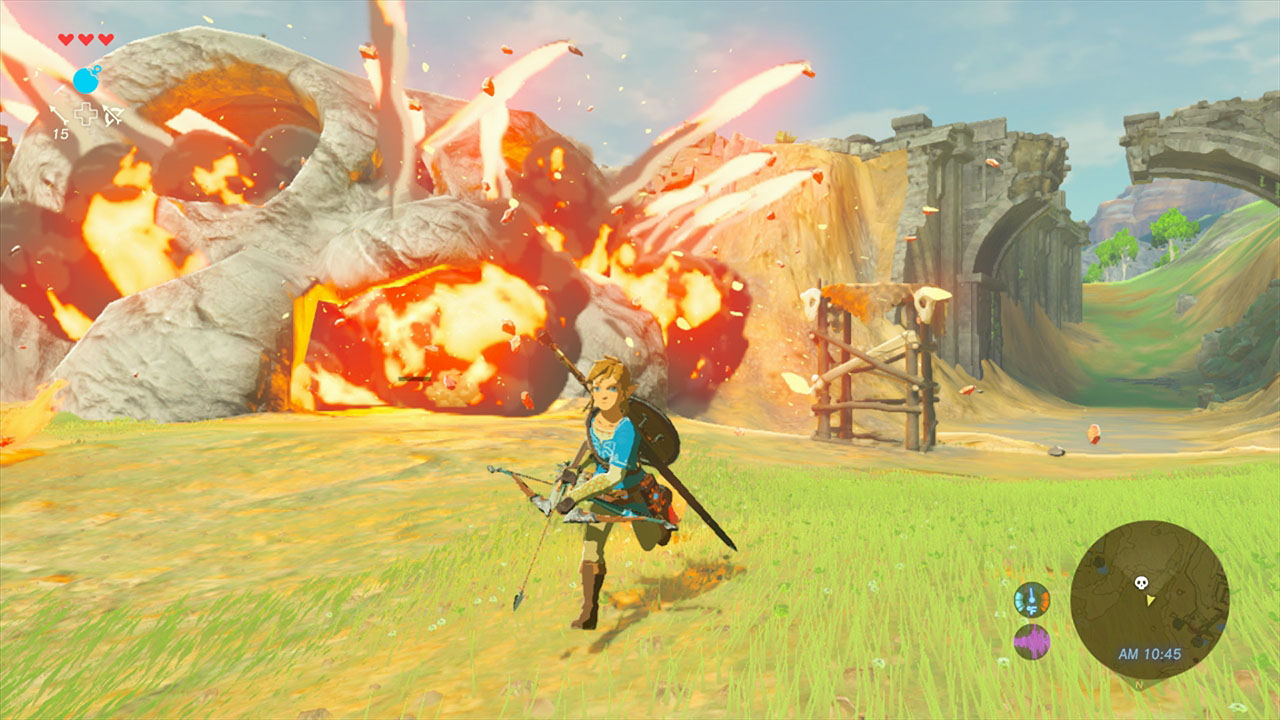
Hyrule Snap: In terms of tracking the player’s progression, there are lots of things to do: 120 Shrines, nearly 100 side quests and main ‘story’ quests, but none of them are technically required to beat the game, bar one: ‘Defeat Ganon’. Technically you’re able to zip straight to Ganon’s castle after completing the Plateau, which is all well and good, but for me personally, I’m a bit of a progression fiend. I like the sense of gradually ‘completing’ a game, and being able to mark my progression as I go.
Seeing my shrine and quest completion increase was fine, but the feature of the game that scratched this itch best for me was the camera built into the Sheikha slate. Akin to the same thing in Wind Waker, every animal, enemy, weapon and plant can be added to the ‘Hyrule Compendium’ by snapping a picture of it, turning the meta-game into something of an open-world Pokemon Snap. I got a mini jolt of excitement when I’d open up my camera to find the object I was looking at surrounded by an orange box, indicating I hadn’t yet snapped it, and often found myself more engrossed in this Hyrule Snap than the main game itself.
Gliding: The best tool in your arsenal is the paraglider. I’d like to see the percentage of time I spent soaring through the air as opposed to traversing the ground. I suspect it’d be quite close between the two. Hyrule has been designed with vistas in mind – there are hundreds of mountains, rolling hills, steep cliffs, and isolated look-out towers that beg to be ascended, and once you do you’ll inevitably spy another dozen that you’ll want to glide over and check out. Whilst gliding depletes your stamina meter, it does so at such a slow rate that it’s never really an issue, and lets you enjoy the beautiful landscape and traverse the vast lands in the best possible way.
It’s also enjoyable to use in battle – lighting a fire under yourself and shooting upwards, then whipping your bow out for some bullet-time arrow sniping is always a good time.
Handheld beauty: I was impressed with how the game performed in the Switch’s handheld mode. Even though the resolutions dips from 1080p to 720p, on the smaller screen it actually looks better in some ways than when on a large TV. Even though a game of BotW’s scope deserves to be blown up full-size, it ran and performed really nicely in handheld mode, with the framerate only noticeably dipping in specific areas.
Sound design: Equally as important as the music in Zelda games is the general sound design of the world. Different games in the series have had different types of effects based on their atmosphere, and all have worked well to supplement it. The way a rupee clinkles when collected, or an enemy growls or Link yelps and grunts his way through the adventure are important, and BotW delivers. Practically every sound has a lovely charm to it, down to the little jingle when you pick up a weapon, ingredient or rupee, and it amounts to build a charming atmosphere that is uniquely Zelda.
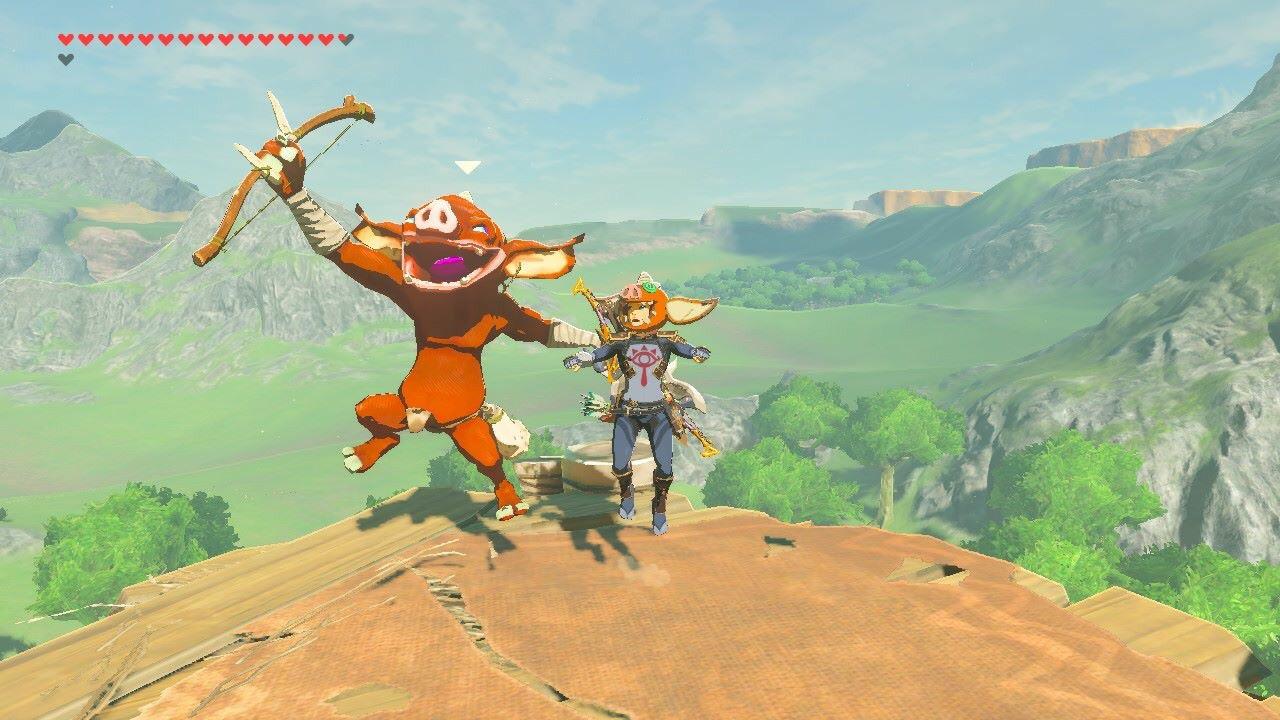
Lifelike enemies: The way enemies act and respond in BotW is impressive. The Bokoblins in particular seem to have been given special attention when it comes to realistic behaviour, and can act in any number of unexpected ways when approached. When you stumble across an enemy camp, they could be up to all manner of things; kicking some fruit around, cooking food, sleeping, chatting, fighting, chasing some animals – and it really serves to give the impression that they’re more than just placeholder enemies. Their facial expressions and noises are also excellent and varied.
Hearts and stamina: The way BotW deals with your health differs from traditional Zelda games, which typically gave you a heart container as a reward for discovering a secret or achieving something in the game. This time around, in keeping with the game’s increased emphasis on player autonomy, when you beat a shrine you’ll get a ‘Spirit orb’, four of which can be exchanged either for a notch on your stamina wheel, or a heart. This is great because it allows the player to either go for safety in the form of more health, or to be more bold with increasing stamina. It’s just a shame there’s a limit to both, allowing you to max both out by doing all the shrines, as it would be fun to go crazy stamina-wise at the expense of low health for the entire game.
Lovely little rumours: Another big thing I’ve found lacking in recent Zelda titles is the depth of the mystery and the crafting of the secrets in the games. In the original Zelda on the NES, you were given subtle clues by NPCs dotted around the world as to the whereabouts of temples and weapons, which was an effective way of keeping an aura of mystery about the world, and allowing for discovery and figuring out of secrets to be a satisfying experience. Fast-forward to Skyward Sword, and your sidekick Fi literally spells out the solutions to puzzles and objective locations, sapping all the satisfaction away from the player.
Thankfully BotW marks a glorious return to riddles and mystery of the series’ origin, with the world littered with hints as to the whereabouts of certain things. Some shrines themselves are hidden behind riddles through song lyrics, and the entire Zelda memory quest requires you to look at images and determine where exactly they are in the world (a mechanic I had mistakenly thought existed in Twilight Princess via the paintings in Ganondorf’s castle, only to find they were just there for decoration). Talking to NPCs will also once again give you clues about things scattered across Hyrule, and each Stable contains a book of ‘rumours’ about something in the world that can be discovered. It really does feel good when you decipher a riddle and discover something; it feels like you discovered it, rather than the game shoving it at you.
Red vs Blue: I’ve mentioned the beautiful vistas of Hyrule already, and how the game entices you to venture off into the distance towards a misty peak poking over the horizon. What the game is really clever with, and something I only picked up on midway through the game, is the subtle colour-coding it uses to entice you to keep going. Once you beat a shrine, its red lighting effect turns blue to signify it’s been conquered. Straightforward enough. But I started noticing this code exists elsewhere in the game too – unconquered towers will glow red and turn blue once activated, treasure chests are red before they’ve been opened. Enemies glow red. The game trains you to ‘look out for glowing red’ as you go along, and you’ll be subconsciously painting the red world blue as you go. Neat.
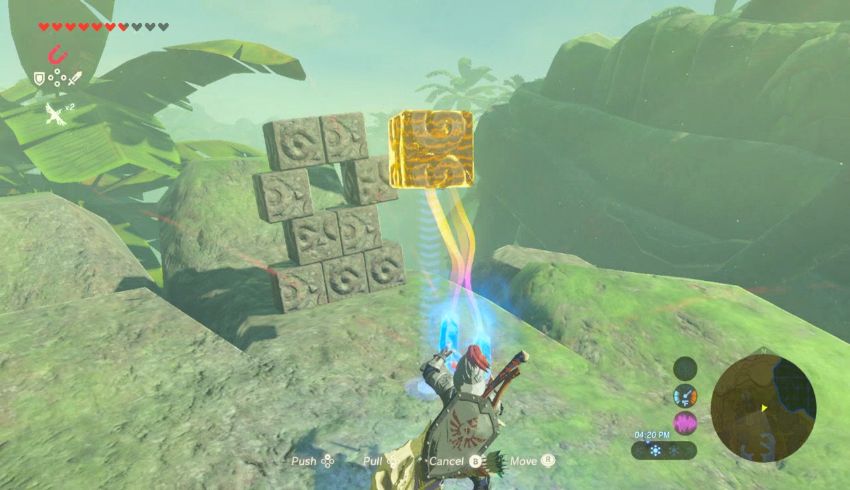
Metropolis: Every Zelda game has had urban areas – villages, towns and citadels in which the people of Hyrule dwell, and they serve as key areas of the land when it comes to picking up new quests, progressing the story or just relaxing for some mini-game downtime. In my view each game has had varying success with these areas, a lowpoint being Twlight Princess’ Castle Town, which whilst big wouldn’t even let you speak to most of the townsfolk, rendering it empty and feeling pointless. Skyward Sword’s Skyloft on the other hand was excellent, brimming with fun characters, details and secrets, and really feeling alive. Majora’s Mask’s Clock Town is another obvious good example.
The towns in BotW are definitely a positive. They were real highlights of the game for me, with each area containing even more detail and secrets than Skyloft – an impressive feat considering Skyloft was the main hub of SS, and it’s entirely possible to beat BotW without even discovering some of the towns in the game. Kakariko Village is probably the highlight, semi-hidden in some misty Machu Pichu-esque mountains (all of which are scalable and hide their own secrets, of course), but every village has its own unique style of home and overall flavour. There are shops, taverns and homes in each town of course, all of which can be seamlessly entered and exited without the usual Zelda loading screen, and each town has its own musical melody. This is what towns in a Zelda game should be.
Old names now seem real: In keeping with tradition, you’ll find familiar place names acorss Hyrule. Lake Hylia, Death Mountian, the Lost Woods – they all make an appearance. The difference now is thanks to the scale of the game, the places actually feel like their namesakes. Lake Hylia is actually a vast stretch of open water, Death Mountain is a multi-layered towering inferno of rock and lava, And the Lost Woods (possibly my favourite location) is a spooky misty wooded maze that feels like a forest. Previous games in the series ask you to suspend your disbelief with these locations, but in BotW they feel like a 1:1 rendition.
The Mixed
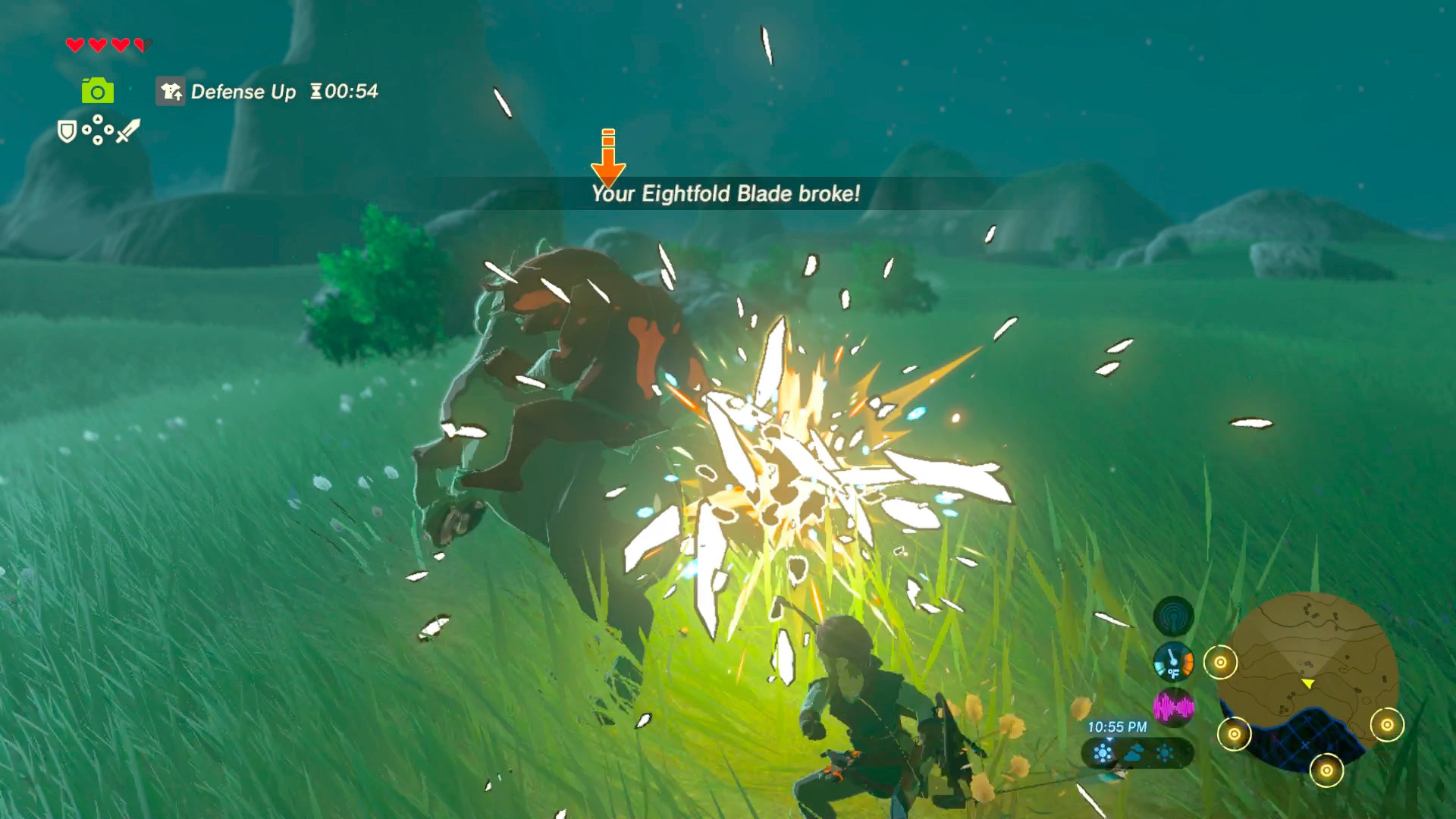
Weapon breakage: Although I tried my best to avoid spoilers going into BotW, one unescapable point of contention was the weapon durability. The most notorious feature of the game, all weapons now break after a certain number of uses. More powerful weapons tend to be more resilient and thus take more thwacks to break, but they’re still done with pretty quickly.
This is a mixed feature for me, because it does have the intended effect of making you try more weapons rather than sticking with one super sword, but everything just feels a bit too brittle. Nintendo have gone to the extreme with it. I’d go as far as to say that doubling the strength of every weapon would have struck the right balance.
Tablet powers: A key feature of the game is the Sheikah Slate powers you become endowed with early on; Ice, Magnesis, bombs (round and square), and stasis (time freezing). These are all well-done and easy to use, but they’re a very mixed bag in terms of utility. The bombs are brilliant, and with the fragility of the weapons you’ll be using the bombs constantly to attack enemies and break things. Stasis and magnesis have their uses too, but the ice power is really just used for traversing across water in tiny increments. They all feel a bit under-baked, particularly stasis and ice, which is a shame because they have bags of potential. Being able to freeze water in more ways than just a small block would have been fun to experiment with, and stasis has incredible implications, particularly when tied with the accumulation of hits that can send an item flying. The physics in the game engine are there, it’s just there aren’t enough opportunities to use it. For instance you’ll see some rocks next to an enemy camp that could be used to stasis-bomb them, but it’s just so laborious and unreliable that I found I was better off just chucking a load of bombs in there.
Ubi towers: I mentioned in the Good section abut how non-Ubisoft like the open world was in BotW, and how this benefits the game. There’s one element though that Nintendo seemingly couldn’t resist refraining from adding – the towers. The map is broken up into regions, and each has its own tower, which you must scale to open up that region on the map. The most thrilling parts of the game for me were when I was traversing an ‘unlocked’ part of the map, not knowing what might come around the corner. With the towers, unlocking a large area I hadn’t yet explored just felt a bit wrong, and not in-keeping with the spirit of the game, but at least they don’t reveal every secret of the map, Ubisoft-style.
Puzzle variety: I’ve mentioned the Korok seed collecting and how every inch of the world feels unique and has something worth discovering. This is true, but due to the sheer size of the map, playing for long enough things do start to err on the repetitive side slightly, particularly with the Korok puzzles. After a while you’ll know what a circle of lily pads or a hole in the ground with a boulder nearby requires, and I found myself feeling like I was going through the motions a little with some of them due to the repetitiveness. As with the Slate powers, three or four more variants of puzzle type would really have benefited here.
Elemental: The way everything interacts with each other in BotW is really quite impressive. Things you would expect to affect Link’s temperature, like carrying a lit torch, standing near some ice, or moving in and out of shade, all do have the intuitive expected effect. This is best seen with the cooking – throw together some ingredients in a cooking pot and generally, if the ingredients make some kind of logical sense, you’ll cook up something good.
The only issue is that, as with the Slate powers, utilising clever elemental tricks or cooking up a nice meal that restores 6 hearts is often more trouble than it’s worth. It’s much quicker to just guzzle down ten apples than to cook an apple pie. It’s much easier to climb up a nearby cliff and glide over the river than to chop down a tree and use the log as a boat, which the designers would no doubt prefer you do.
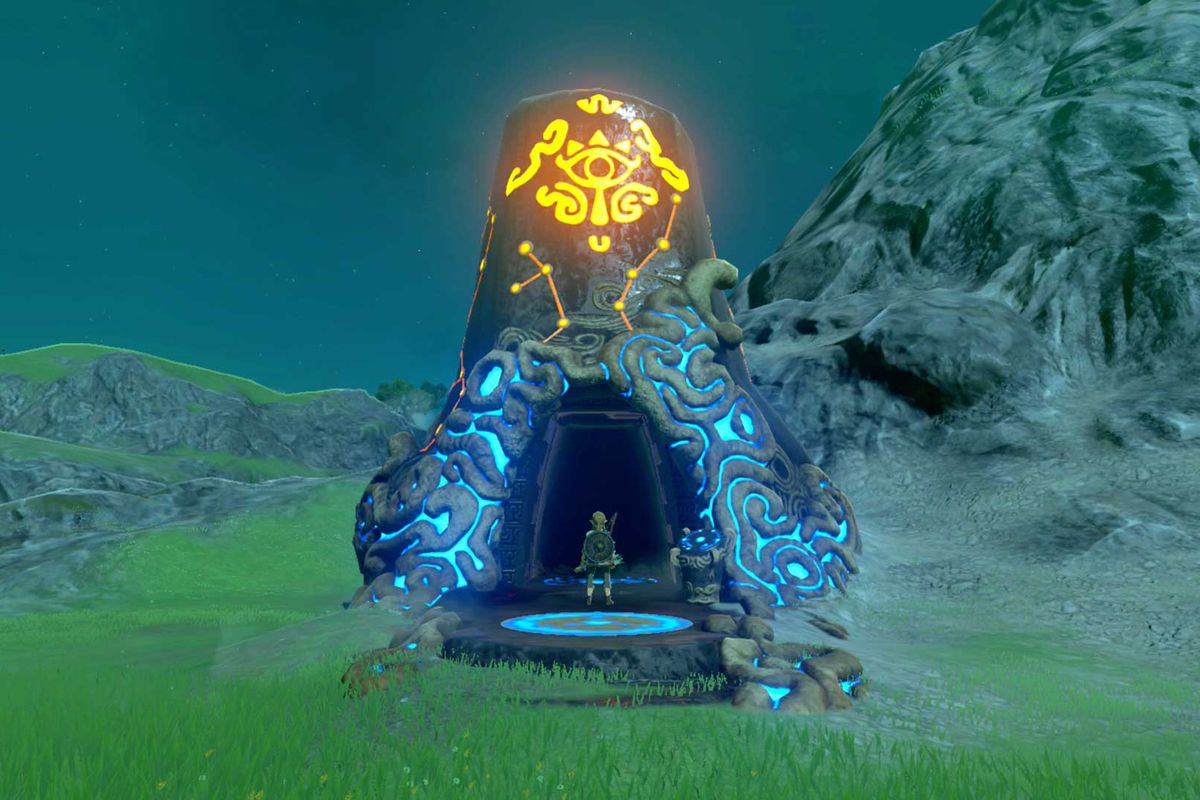
DLC: BotW is the first ever Zelda game with DLC, and some of it is great. It ranges from new tools and armour to a full new set of shrine challenges, the latter of which are fine but not quite worth the money. My most used parts of the DLC were the individual items, which in a nice touch aren’t just given to the player, but hidden somewhere in the world with the player given riddles to figure out their location. Excellent stuff.
Two items really changed the game for me in particular; the Hero’s Path and the Korok Mask. Hero’s Path marks your entire journey on the map, showing you where you’ve been and where you haven’t been, allowing you to visually replay your entire journey from the beginning of the game. It’s a lovely feature as it serves as a reminder of your adventure so far, and genuinely did jog my memory of events (which would be unique to me as a player), and it served to show me areas I hadn’t explored yet, so ensured I found any given big spot of Hyrule that I may have otherwise missed.
Donning the Korok Mask helped the completionist in me, as it would rattle every time I was near an undiscovered Korok seed. Really useful, of course, but the reason this is in the ‘Mixed’ section is because both the mask and the Hero’s Path were something of a double-edged sword. Whilst the Path showed me places I hadn’t been, as a consequence I found myself totally uninterested in going anywhere I had already been, thus potentially missing out on further secrets in already-trodden areas. Worse still, the Korok Mask made me avoid exploring in detail anywhere my mask wasn’t rattling, making me a quasi-slave to the Mask itself, and defeating the purpose of the Korok seeds in the first place, which is to study and appreciate your surroundings. In the end I forced myself to not wear the mask, and enjoyed the game more for it. It’s perhaps best left until the end of the adventure, when you’ve explored the world organically already, and just want to mop up the remaining seeds.
Horses: A lot of effort has gone into the horses in BotW – the variety of colours and types, the beautiful animation and character, and the entire stables system that lets you save and name any horse you find. There’s even a Great Fairy specifically there to resurrect any of your dead horses. The trouble is, travelling by horse is completely unnecessary, and is actually less useful than other methods.
I found that if I wanted to explore a region, I was better off running/walking, as the horses are too quick to truly soak up/inspect surroundings. If I wanted to go somewhere fast, I could either fast travel, or better still, paraglide. The motorcycle DLC is the final nail in the coffin for the horses in BotW, sadly making them the game’s most redundant feature.
Reward variety: You can probably tell that variety is a running theme in this section of the review. Intangible rewards-wise, BotW is brilliant – the feeling of discovering new parts of the world, inherent satisfaction of beating enemies or clearing a Shrine, all work very well. However in terms of tangible rewards for the player’s actions, which are equally as important in a game like that, BotW suffers a little in terms of variety.
We’ve got: weapons, Shrine orbs, clothing items, Korok seeds (which lead to inventory expansion) and rupees. That’s about it in terms of extrinsic rewards. Most chests contain weapons, which of course break after a while. What the game really needs is more unique items that can serve as rewards. The game flirts with this idea at times, one good example being the Monster Shop quest, which rewards you with a unique Dark Link outfit that has unique powers (where most clothing items just have the same range of standard stats). More items like this and the Korok Mask should be in the game as rewards for the mini dungeon segments and bandit camps that pop up, rather than jut another Great Flameblade (which you might have broken a version of already by actually defeating the camp).
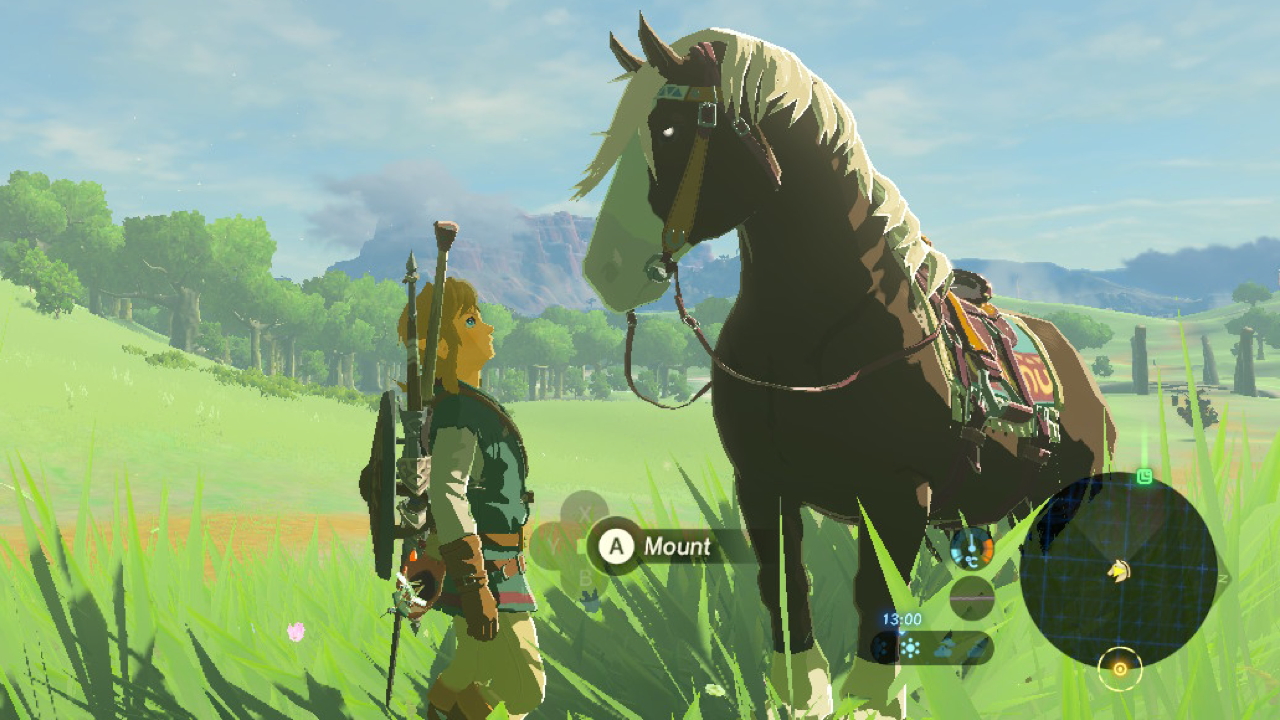
Sidequests: BotW is chock-full of sidequests and optional journeys to go on. Basically everything you can do is a optional bar a few Shrines and beating Ganon. But the sidequests you pick up from NPCs specifically make up the meat of the non-shrine content of the game, and these range in quality. As mentioned, the more riddle-based quests are more exciting, and some of the shrine quests are brilliant – one requires you to jump off a mountain and angle your view so another mountain looks like a giant bird – using BotW’s excellent landscape as a puzzle in itself. However the majority of the sidequests are nothing more than repetitive fetch quests. For every mountain bird discovery, there are 8 “bring me 10 lizards” that dilute the experience.
NPCs: BotW has more NPCs than any other game in the series, and best of all, they’re all unique, with their own names and dialogue, many of which lead to sidequests. The sad part is, despite spending over 150 hours in the game, I can only recall a handful of them. Compared to the likes of the Wind Waker, which had a cast far more memorable, this is a bit of a shame. The main characters too, like the heroes of each region, also don’t linger long in the mind.
Beastly: There are no dungeons in BotW, yet another first for the series. Instead, you’ve got your 120 shrines, plus four optional Divine Beasts, each of which can be beaten and used to help you in the final battle against Ganon (though just but whittling down his health before the battle, not in any interesting way).
Each beast is a giant mechanical animal, with a puzzle-filled interior that you solve to purge Ganon’s spirit from it. They serve as a kind of mini-dungeon, as they’re no where near as big of complex as dungeons of previous games, so calling them such doesn’t quite feel right. The Divine Beasts are a welcome change form the shrines, and some of the puzzles involving moving parts of the beasts are enjoyable, but they just don’t quite scratch the itch of proper dungeons, and the game doesn’t quite make up for this absence.
Percentage missing: A small thing, but after you defeat Ganon the game gives you a completion percentage viewable on the map. This is great and of course encourages you to keep discovering things, but bafflingly there are several key things omitted from the calculation. Items in the compendium and side quests don’t count, which seems like an odd decision.
The Bad
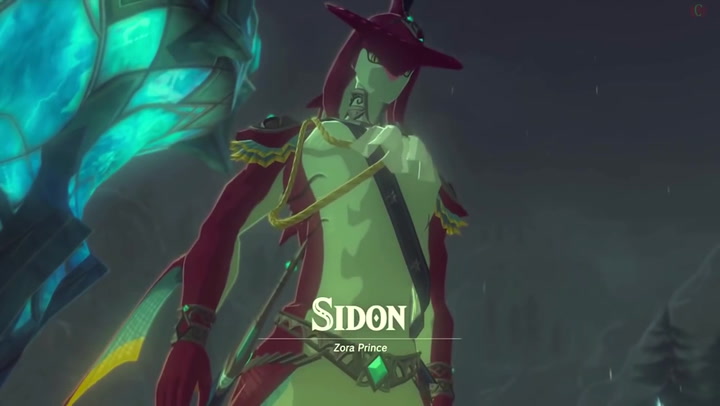
Draw distance and textures: As visually impressive as the game is, particularly given the limitations of the hardware, the draw distance pop-in is sometimes a bit too distracting. Nintendo have been clever and ensured key things like shrines and towers don’t suffer the issue, so the red glow of the shrines can be spotted in the distance, but at times key things like enemies and buildings pop in very close to where you are, particularly when gliding around.
I miss the indoors: The great wild outdoors is so well done in the game that this may seem like a silly point, but the few indoor areas of the game really made me wish that there were more of them. Ganon’s castle being the best example – a huge, multi layered palace with its own hidden rooms, secrets and winding corridors that’s done so well it made me yearn for some proper interiors to explore elsewhere. Something for the sequel to expand upon no doubt.
Voice acting: Another first for a Zelda game, many of the main characters have voice acting. The quality is very mixed, but the worst thing about it is that it feels just so unnecessary. The majority of the speech in the game is text-only, even with the characters that have voice actors! It’s jarring going from a voice acted conversation straight into a text convo with the same character. As a result it feels totally unneeded, at-odds with Zelda’s style, and frankly sucks some of the charm from proceedings.
Wii U legacy: BotW was originally designed for the Wii U, and you cant help but feel that it would have benefited from the dual screen system. Pausing the game to switch weapons mid battle after yet another breakage, or navigating menus to check the huge map – these processes would’ve been much smoother had they been at the click of a touchscreen. We know the designers originally intended for this to be the way thanks to early footage of the game, but the need for the game to launch on Switch meant we got the system we got.
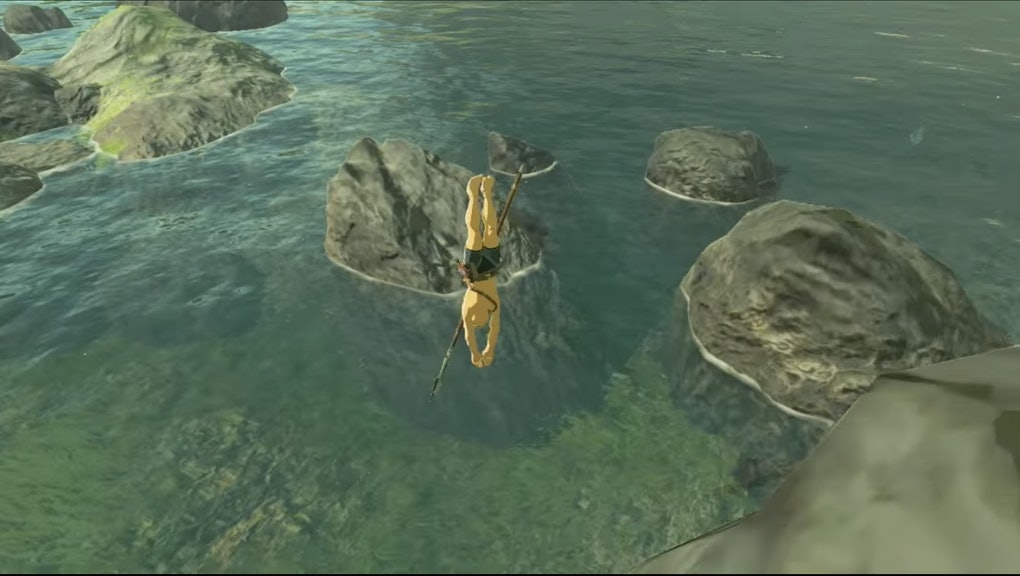
Swimming is hideous: For some reason Link is a pathetic swimmer in this game, and it’s the first 3D Zelda game where swimming underwater isn’t a factor. All the Zora outfit does is let you swim up waterfalls. swimming is painfully slow, and worse, depletes your stamina, so you’ll often ‘drown’ pathetically just by trying to doggy-paddle to shore. This must have been down to time constraints with development, and something that will hopefully be sorted in the sequel.
Music: Another massive change for the series, the musical sound direction for the music is vastly different in BotW than previous entires. Booming orchestral soundtracks were a cornerstone of previous entries, but with BotW we get a much more toned down, subdued score. It definitely works in the quiet moments I mentioned earlier, and helps to build a sense of post-apocalyptic foreboding over everything, but the times when music does play it just doesn’t reach the same catchy heights as previous entires. Except the Lost Woods tune. That’s good.
I’d also add that it’s the first Zelda in a long time not to feature a playable musical instrument. This felt like a bigger omission the longer I played, and I’m surprised they didn’t add something that changed the weather or moved time forward, as those elements play such significant roles in the game.
No more Metroidvania: A necessary sacrifice, but it’s still missed all the same. By endowing you with all your powers right from the get-go and thus unleashing freedom to the player, gone is that lovely sense of discovery that the other games allowed for. Coming across a large boulder early in game, then returning to it once you acquired bombs or a power glove and being able to lift/destroy it to reveal a secret was something the series did so well. Whilst there’s still a lot of joyful discovery to be had with BotW, that sense of ‘go-back-to-that-thing-you-can-now-access’ Metroidvania style mechanic is now lost.
Shrine challenges/themes: The Shrines are too simplistic and easy. There’s 120 of them, but most of them can be completed in under 5 minutes, and don’t expand upon concepts they introduce. One shrine has you shooting down ropes attacked to pendulums, then freezing the pendulums with stasis at a certain point. This is a neat concept, but sadly the shrine ends before you have to do anything too interesting with it. I’d have preferred the game had, say, 75 Shrines as opposed to the 120, and made each of them slightly longer and more complex.
Another issue with the shrines is the atmosphere. All the shrines have the same decor and music – giving off semi futuristic, clean temple-esque vibes. By the end I was extremely tired of this aesthetic, and yearned for some variety. Very rarely too do the shrines relate to where they are in the overworld, the only one springing to mind being the two connected shrines on the Twin Peaks. It would’ve been nice for a shrine found in the forest a forest to be forest-themed, and likewise with Death Mountain, etc.
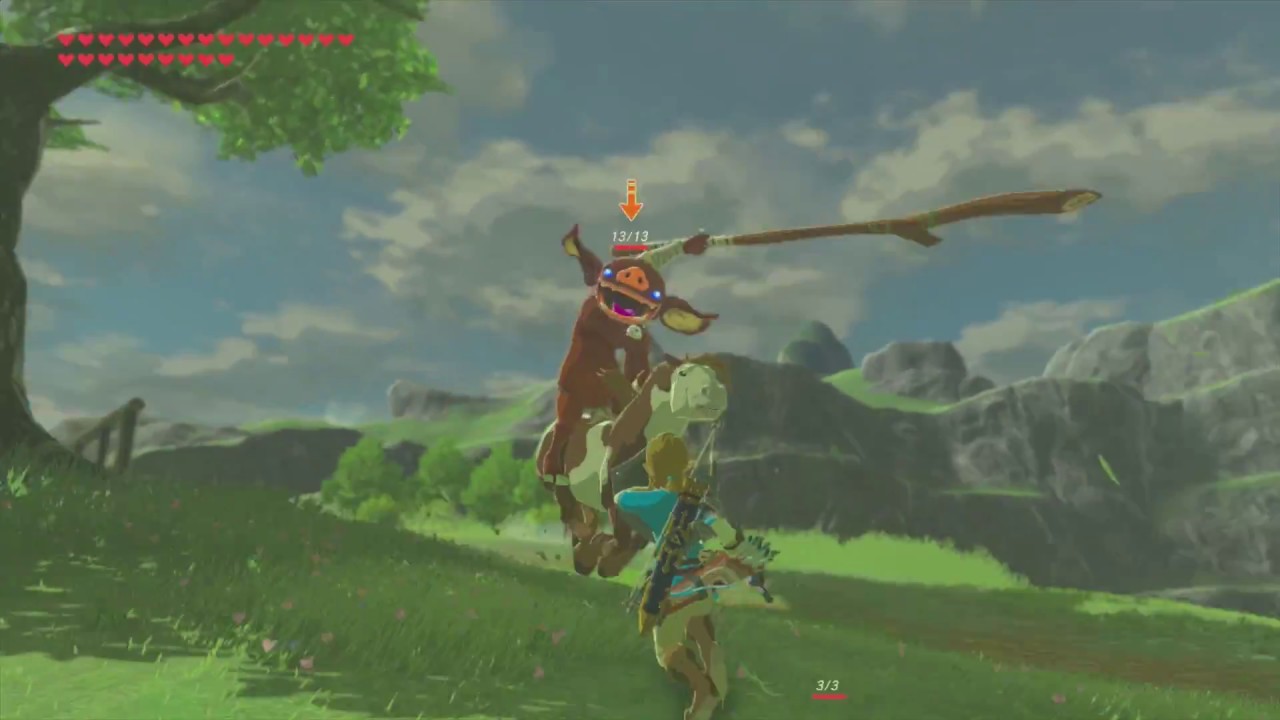
Clothing stats underbaked: Every piece of clothing in BotW has a ‘level’ number attributed to it, and only late into the game did I realise this number was literally the armour number, i.e. how much damage Link can take. Some clothing items have other attributes too, like heat resistance or shock resistance, and these can be improved upon at a Great Fairy fountain. However, this process just feels like a bit of an afterthought, and many special items of clothing that can be found but not upgraded are left redundant in the late game, as they cant compete with your 5-star Hylian Tunic for strength.
Combat a bit shallow: The combat in the game is fun and functional, but I feel it could’ve been so much more. It’s a key focus of the game, and you’ll spend a lot of your time fighting, so it’s a shame that the game lacks the depth of say, a Dark Souls when it comes to the combat. There are many, many weapons in the game, but they all come in just a handful of types (sword, greatsword, spear, bow, club), with these types all have the same animations and moveset. Link can parry which is nice, and can dodge – with a correctly timed dodge triggering a slow-mo flurry aciton. The trouble is, what makes a dodge successful and worthy of the flurry seems completely random, and doesnt seem to match up with the move an enemy makes. A small hint or cue showing when to dodge would’ve gone a long way in rectifying this. What’s more, you can’t develop or build on your fighting skill as you could in Twilight Princess, which feels like a step back.
Spongey enemies: Some of the enemies, especially the more difficult Black and Silver variants that appear later in the game, are just ridiculous in how spongey they are. Some of them take far too long to defeat health-wise, and eventually I found myself avoiding confrontation altogether through fear of breaking multiple weapons on one Silver Lizalfos.
Ganon: The final boss fight is forgettable and felt very rushed. That’s all I’ll say on that.
Sailing: The water of BotW is one if its best features – the lakes and rivers all connect and make the world feel real, and the surrounding sea is beautiful and begs to be explored. I’ve already mentioned my gripes with the swimming, so surely sailing is at least a better alternative? Sadly, it’s even worse than the swimming. The only boats available are small rafts that have to be propelled along by Link himself with a Korok leaf – the only item in the game that can do so. It’s hard to control, slow and dull. A far cry form the excellence established by the Wind Waker in this department and a real wasted opportunity. I’d love to spend hours gliding through the rivers of Hyrule, but it just isn’t worth it.
Rain: Every time it rains, climbing anything is rendered almost impossible, as it makes you slip 4 paces down for every 5 you climb up. This means you run out of stamina very quickly without really getting anywhere. Sometimes the rain goes on for five minutes or more. There’s no way to stop it, and there’s no way to get around the climbing problem. If they had made it just require more skill to climb in the rain (i.e. doable, but more tricky) or given you a clothing garment or item that made the rain stoppable, then that would be fine, but as it is it’s just an annoying broken feature.
Divine quests: Every Divine Beast quest in the game follows the same exact pattern: meet an important person of one of the races, who happens to be a descendant of a long-dead important person of said race, stop the divine beast and summon spirit of said dead person to help shoot the beast’s laser at Ganon. There is absolutely no variance in this pattern, which is odd, and serves to dilute the memory of the characters and weaken the overall plot.
Moon looks shit: For a series that has had such a great relationship with the moon, I was shocked to see how bad the moon in BotW looked. Just look at it:
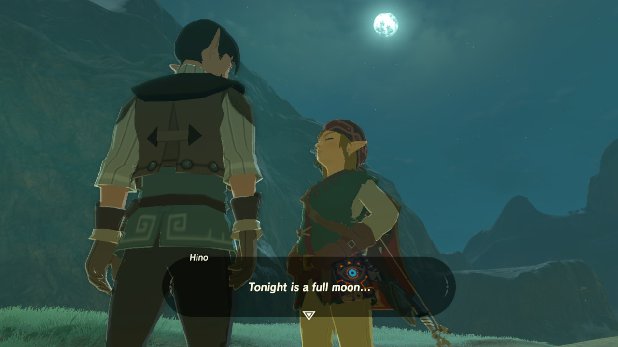
Overall
BotW is a game greater than the sum of its parts. And its parts are pretty great already. I absolutely scoured every inch of Hyrule in my 150+ hours played, hopelessly addicted to the sense of discovery and adventure that I haven’t really experienced in a game before or since. BotW succeeds despite all the minor issues and things it could have done better, and is absolutely worth playing today.
You can buy Breath of the Wild from Amazon here.